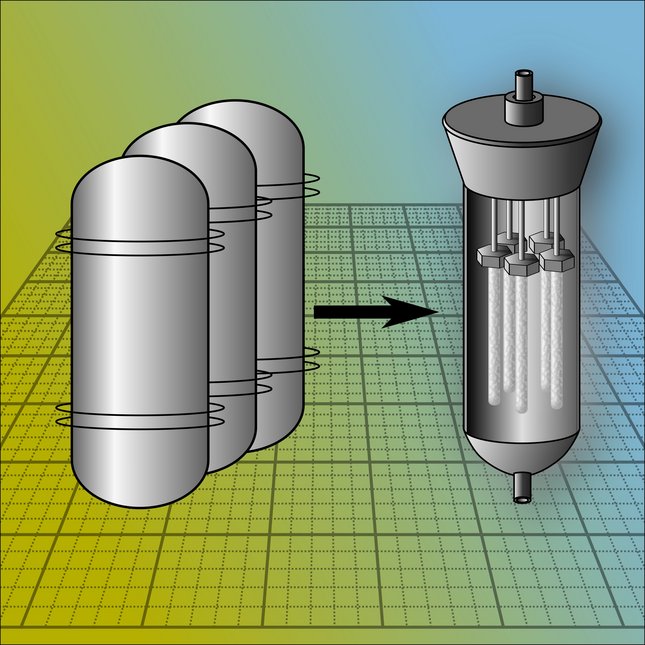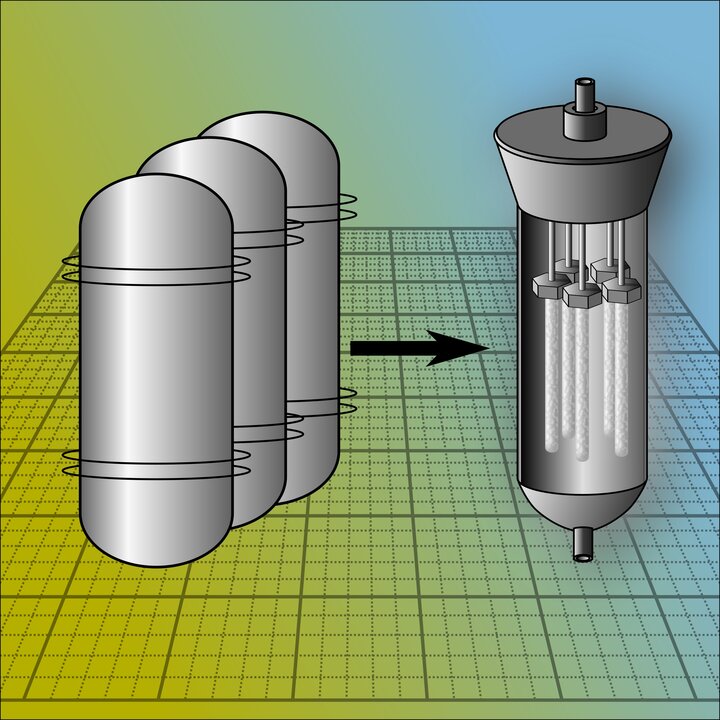
Membrane reactors
Packed bed and fluidized bed membrane reactors are being investigated formany different applications (a.o.hydrogen production, syngas production, oxidative dehydrogenations, partialoxidations) exploiting conversion and selectivity improvements via selectivereactant feeding orproduct extraction; An important research objective is to study in detail theimprovement of fluidization characteristics and decrease of concentration polarization via proper insertion through submerged permeating membranes influidized bed membrane reactors.In addition, decrease of concentration polarization effects in packed bedmembrane reactors are investigated by structuring of the packed bed using 3Dprinted reactors (e.g. for the methane dehydroaromatization for H2production).
Chemical-looping processes
Chemical looping processes integrate air separation or CO2 capture by exploiting oxygentransport via solid oxygen carriers.Both interconnected fluidized bed systems and the in-house developed CLCprocess with dynamically operated fixed beds are intensively studied. An example of a process thatis studied is the chemical looping oxidative dehydrogenation of propane topropylene.
Sorption-enhanced processes
Insorption-enhanced processes one of the products is adsorbed onto a sorbent toenhance the conversion and circumvent equilibrium restrictions. Examples thatare being invested include SEWGS (sorption-enhanced water-gas-shift) and SESMR(sorption-enhanced steam methane reforming), where CO2 is adsorbed,and SEDMES (sorption-enhanced dimethyl ether synthesis), where steam isadsorbed.
Inaddition, hybrid concepts are being studied, such as the Ca-Cu process (whereSESMR with CaO is combined with chemical looping of Cu/CuO to provide therequired energy for the calcination of the CaCO3 formed during theSESMR step) and the membrane-assisted sorption-enhanced reforming (MASER, combiningSESMR with membrane separation for H2 production). Another exampleof reactive adsorption/desorption is the combination of direct air capture withthe activation of the adsorbed CO2 via e.g. methanation.
Reactive extraction
Processintensification by reactive extraction is investigated using novel bio-basedsolvents, which includes the development of novel deep-eutectic solvents, forexample for the conversion of biomass-derived xylose to furfural orhydroxymethyl furfural (HMF) or for the chemisorption of CO2 inpost-combustion capture processes, as well as the integration of the solvent regenerationwith supported liquid membranes.
Membrane reactors
Packed bed and fluidized bed membrane reactors are being investigated formany different applications (a.o.hydrogen production, syngas production, oxidative dehydrogenations, partialoxidations) exploiting conversion and selectivity improvements via selectivereactant feeding orproduct extraction; An important research objective is to study in detail theimprovement of fluidization characteristics and decrease of concentration polarization via proper insertion through submerged permeating membranes influidized bed membrane reactors.In addition, decrease of concentration polarization effects in packed bedmembrane reactors are investigated by structuring of the packed bed using 3Dprinted reactors (e.g. for the methane dehydroaromatization for H2production).
Chemical-looping processes
Chemical looping processes integrate air separation or CO2 capture by exploiting oxygentransport via solid oxygen carriers.Both interconnected fluidized bed systems and the in-house developed CLCprocess with dynamically operated fixed beds are intensively studied. An example of a process thatis studied is the chemical looping oxidative dehydrogenation of propane topropylene.
Sorption-enhanced processes
Insorption-enhanced processes one of the products is adsorbed onto a sorbent toenhance the conversion and circumvent equilibrium restrictions. Examples thatare being invested include SEWGS (sorption-enhanced water-gas-shift) and SESMR(sorption-enhanced steam methane reforming), where CO2 is adsorbed,and SEDMES (sorption-enhanced dimethyl ether synthesis), where steam isadsorbed.
Inaddition, hybrid concepts are being studied, such as the Ca-Cu process (whereSESMR with CaO is combined with chemical looping of Cu/CuO to provide therequired energy for the calcination of the CaCO3 formed during theSESMR step) and the membrane-assisted sorption-enhanced reforming (MASER, combiningSESMR with membrane separation for H2 production). Another exampleof reactive adsorption/desorption is the combination of direct air capture withthe activation of the adsorbed CO2 via e.g. methanation.
Reactive extraction
Processintensification by reactive extraction is investigated using novel bio-basedsolvents, which includes the development of novel deep-eutectic solvents, forexample for the conversion of biomass-derived xylose to furfural orhydroxymethyl furfural (HMF) or for the chemisorption of CO2 inpost-combustion capture processes, as well as the integration of the solvent regenerationwith supported liquid membranes.
